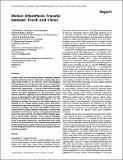Motion Aftereffects Transfer between Touch and Vision
Author(s)
Konkle, Talia A.; Wang, Qi; Hayward, Vincent; Moore, Christopher I.
DownloadKonkle-2009-Motion Aftereffects.pdf (326.7Kb)
PUBLISHER_POLICY
Publisher Policy
Article is made available in accordance with the publisher's policy and may be subject to US copyright law. Please refer to the publisher's site for terms of use.
Terms of use
Metadata
Show full item recordAbstract
Current views on multisensory motion integration assume separate substrates where visual motion perceptually dominates tactile motion 1 and 2. However, recent neuroimaging findings demonstrate strong activation of visual motion processing areas by tactile stimuli 3, 4, 5 and 6, implying a potentially bidirectional relationship. To test the relationship between visual and tactile motion processing, we examined the transfer of motion aftereffects. In the well-known visual motion aftereffect, adapting to visual motion in one direction causes a subsequently presented stationary stimulus to be perceived as moving in the opposite direction 7 and 8. The existence of motion aftereffects in the tactile domain was debated 9, 10 and 11, though robust tactile motion aftereffects have recently been demonstrated 12 and 13. By using a motion adaptation paradigm, we found that repeated exposure to visual motion in a given direction produced a tactile motion aftereffect, the illusion of motion in the opponent direction across the finger pad. We also observed that repeated exposure to tactile motion induces a visual motion aftereffect, biasing the perceived direction of counterphase gratings. These crossmodal aftereffects, operating both from vision to touch and from touch to vision, present strong behavioral evidence that the processing of visual and tactile motion rely on shared representations that dynamically impact modality-specific perception.
Date issued
2009-05Department
Massachusetts Institute of Technology. Department of Brain and Cognitive Sciences; McGovern Institute for Brain Research at MITJournal
Current Biology
Publisher
Elsevier B.V.
Citation
Konkle, Talia, Qi Wang, Vincent Hayward, and Christopher I. Moore. “Motion Aftereffects Transfer Between Touch and Vision.” Current Biology 19, no. 9 (May 2009): 745–750. © 2009 Elsevier Ltd.
Version: Final published version
ISSN
09609822